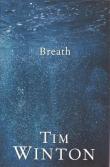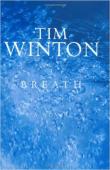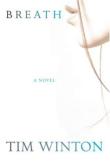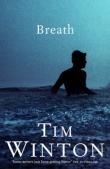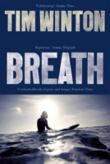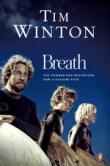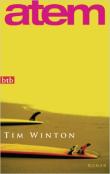AustLit
Latest Issues
AbstractHistoryArchive Description
Source: Publisher's website
Adaptations
-
form
y
 Breath
( dir. Simon Baker
)
Australia
:
See Pictures
Gran Via Productions
Breath Productions
,
2016
8569342
2016
single work
film/TV
Breath
( dir. Simon Baker
)
Australia
:
See Pictures
Gran Via Productions
Breath Productions
,
2016
8569342
2016
single work
film/TV
'Based on Tim Winton’s award-winning novel set in mid-70s coastal Australia. Two teenage boys, hungry for discovery, form an unlikely bond with a reclusive surfer and his mysterious wife. The boys are driven to take risks that will have a profound and lasting impact on their lives.'
Source: Screen Australia.
Notes
-
Dedication: For Howard Willis.
-
Included in the New York Times Book Review 100 Notable Books List for 2008.
Publication Details of Only Known VersionEarliest 2 Known Versions of
Other Formats
- Large print.
- Sound recording.
- Braille.
Works about this Work
-
Tim Winton’s Pneumatic Materialism
2020
single work
criticism
— Appears in: Interventions : International Journal of Postcolonial Studies , vol. 22 no. 5 2020; (p. 641-656)'The somatic effects of empire can be found in Tim Winton’s “pneumatic materialism”, an aesthetic preoccupation in his novels with moments of anoxia, or the deprivation of oxygen to the brain. This essay will consider how Winton's novel engage with pneumatic materialism in response to questions of uneven development traditionally associated with the Global South, thereby disrupting clear South–North distinctions. By blurring his concerns across the North–South divide, Winton shows a willingness to think of empire as a series of relations that are not bound by national or territorial borders so much as by substances in the air. He does this, I argue, in his use of the breath.' (Publication abstract)
-
Why Are Australian Authors Obsessed with Killing off Kangaroos?
2019
single work
column
— Appears in: The Conversation , 4 March 2019;'Kangaroos are the most visible of Australia’s unique animals, but despite their charm and national icon status, Australian writers perpetually kill them off.' (Introduction)
-
Kangaroos and Predators in Recent Australian Fiction : A Post-Pastoral Reading
2018
single work
criticism
— Appears in: Antipodes , vol. 32 no. 1/2 2018; (p. 94-108) 'When dusk falls in regional Australia, it is common to see mobs of kangaroos ranging in paddocks and on golf courses. They lounge about in family groups in the shade of remnant eucalyptus trees and share the pasture of bovines. They seem peaceful and idyllic, with their wide, dark eyes, cute joeys, and unique gait, and they appear to have close family bonds. They are the most visible and commonplace of Australia's unique animals. Despite all the charm of these awe-inspiring creatures and their status as a national icon, Australian writers perpetually kill them off. Recent Australian fiction has featured native animals that gain substantial narrative agency. Stephen Daisley's Coming Rain (2015) and Louis Nowra's Into That Forest (2012) undertake extended narratives from the perspective of native animals. The dingo and the thylacine, respectively, are given voice in fiction by these works. Domestic, nonnative animals in Australia have also received serious treatment recently by authors such as Eva Hornung and Michelle de Kretser. But Australian stories are less sympathetic toward the kangaroo. One appears struggling in a rabbit trap, doomed and dying in Charlotte Wood's The Natural Way of Things (2015), Tim Winton has one killed on the road, dissected and fed to dogs in Breath (2008). There is an inventory of such examples. Serious treatment of the extinct thylacine abounds, but the kangaroo is often represented as roadkill and dog food. The expendable nature of the kangaroo is a widely held view in Australia, so it is little wonder that this attitude is articulated in our fiction; but it is a bitter irony that the creature that defines us to the rest of the world is perpetually under siege, in life and in literature.' (Introduction)
-
'The Shimmering Edge' : Surfing, Risk, and Climate Change in Tim Winton's 'Breath'
2018
single work
criticism
— Appears in: Commonwealth : Essays and Studies , Autumn vol. 41 no. 1 2018; (p. 19-29)''Breath', Tim Winton's coming-of-age surfing novel, indirectly links the voluntary risk-taking of adolescent surfers with that of a society teetering on the edge of oceanic climate change. This paper draws on risk theory, the sociology of surfing, oceanic studies, and Winton's related writings to provide an ecocritical reading of 'Breath'.' (Publication abstract)
-
The New Historical Novel : Putting Mid-twentieth-century Australia into Perspective
2018
single work
criticism
— Appears in: Commonwealth : Essays and Studies , Autumn vol. 41 no. 1 2018; (p. 7-18)'This article argues that, since 2004 or so, a new kind of Australian historical novel has emerged among practitioners of literary fiction, one concerned with the mid-twentieth century. This new historical fiction has been characterized by an aesthetic stringency and self-consciousness. Though Steven Carroll and Ashley Hay will be the principal twenty-first-century writers examined, reference will also be made to several other writers including Carrie Tiffany, Charlotte Wood, Sofie Laguna, and to the later work of Peter Carey. In all these contemporary books, technology plays a major role in defining the twentieth century as seen historically.' (Publication abstract)
-
[Review] Breath
2008
single work
review
— Appears in: Bookseller + Publisher Magazine , March vol. 87 no. 7 2008; (p. 36)
— Review of Breath 2008 single work novel -
A World of His Own
2008
single work
review
— Appears in: The Advertiser , 26 April 2008; (p. 13)
— Review of Breath 2008 single work novel -
Dark Poetry in the Ocean
2008
single work
review
— Appears in: The Weekend Australian , 26-27 April 2008; (p. 10-11)
— Review of Breath 2008 single work novel -
Breathless Prose
2008
single work
review
— Appears in: The Courier-Mail , 26 - 27 April 2008; (p. 23)
— Review of Breath 2008 single work novel -
The Last Gasp in a Small-Town Life
2008
single work
review
— Appears in: The Sydney Morning Herald , 3-4 May 2008; (p. 28-29)
— Review of Breath 2008 single work novel -
The Rights and Wrongs of Publishing
2008
single work
column
— Appears in: The Age , 15 March 2008; (p. 29) A column canvassing current literary news including comments from Henry Rosenbloom about global publishing rights as well as news of a Dutch translation of Tim Winton's Breath. The Dutch publication appeared some months prior to Breath being published in English. -
Breathing Space
2008
single work
column
— Appears in: The Canberra Times , 26 April 2008; (p. 11) -
The Sea Side of Tim Winton
2008
single work
column
— Appears in: The Age , 25-26 April 2008; (p. 26-27) The Sydney Morning Herald , 25-27 April 2008; (p. 28-29) -
Lost and Foundering Men
2008
single work
column
— Appears in: The Weekend Australian , 10-11 May 2008; (p. 40) -
Surfing the Zeitgeist
2008
single work
column
— Appears in: The Canberra Times , 17 May 2008; (p. 10)
Awards
- 2010 shortlisted Randwick Award for Literature
- 2010 longlisted International IMPAC Dublin Literary Award
- 2009 shortlisted Australian Booksellers Association Awards — Booksellers Choice Award
- 2009 shortlisted Victorian Premier's Literary Awards — The Vance Palmer Prize for Fiction
- 2009 shortlisted Australian Book Industry Awards (ABIA) — Australian Book of the Year
- Western Australia,
- Coast,

